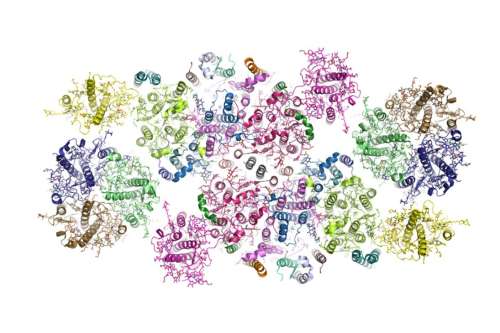Research clarifies light-harvesting process in plants

Photosynthesis, one of the most important biochemical and biophysical processes on earth, provides food and energy for nearly all living organisms (including human beings) in the biosphere. Studying the structures and mechanisms of various aspects of photosynthesis will potentially offer methods to solve increasingly pressing problems concerning energy, food and the environment. These problems create major constraints on the sustainable development of human society.
The primary reactions in plant photosynthesis start with the water-splitting machinery known as photosystem II (PSII). Plant PSII contains two major modules: the light-harvesting system (known as LHCII) and the core complex system. The core complex contains a photosynthetic reaction center and an oxygen-evolving center capable of splitting water molecules under ambient temperature. The reactions in the core complex are powered by the light-harvesting system, which absorbs light energy and transmits it to the core complex.
The detailed architecture of plant PSII has remained elusive for decades. A high-resolution structure of this gigantic supramolecular complex has been highly anticipated in the fields of structural biology and photosynthesis research.
Recently, three groups from the Institute of Biophysics at CAS collaboratively solved the structure of spinach PSII-LHCII supercomplex at a resolution of 3.2 Å through single-particle cryo-electron microscopy (cryo-EM). The work was published in Nature on May 18, 2016.
The spinach PSII-LHCII supercomplex has a total molecular mass of 1.1 megadalton (1 megdalton = 1x106 dalton) and forms a homodimer with two identical units. Each unit contains over 25 protein subunits, 105 chlorophylls, 28 carotenoids and numerous other cofactors. The sophisticated overall structural features and the arrangement of each individual subunit within the supercomplex have been revealed in this study.
Assembly of three different types of LHCII—a major LHCII trimer and two minor LHCII—and the core complex is mediated by three small subunits; their binding sites have now been located within the supercomplex. The result explains the essential roles of these small subunits in stabilizing the PSII-LHCII supercomplex as discovered in previous functional studies.
Details concerning the energy transfer pathways between LHCII and the core complex in the PSII-LHCII supercomplex have, until now, eluded researchers. This new information is vital for understanding the light-harvesting process in plants. By analyzing the pigment networks within the spinach PSII-LHCII supercomplex, the specific pathways between LHCII, CP29, CP26 and the core antenna complexes CP43/CP47 have been defined and described in great detail.
Moreover, the potential energy-quenching sites (forming under high-light conditions) functioning in a regulatory process (known as photoprotection) have been located within the supercomplex. These results are fundamental and will advance studies of the kinetics of energy transfer and the photoprotection mechanism within the PSII-LHCII supercomplex.
More information: Xuepeng Wei et al, Structure of spinach photosystem II–LHCII supercomplex at 3.2 Å resolution, Nature (2016). DOI: 10.1038/nature18020
Journal information: Nature
Provided by Chinese Academy of Sciences


















